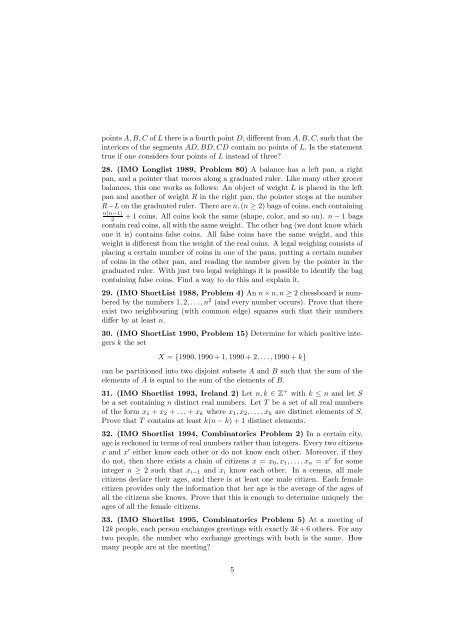Combinatorics Problems
Combinatorics Problems
Combinatorics Problems
Create successful ePaper yourself
Turn your PDF publications into a flip-book with our unique Google optimized e-Paper software.
points A, B, C of L there is a fourth point D, different from A, B, C, such that the<br />
interiors of the segments AD, BD, CD contain no points of L. Is the statement<br />
true if one considers four points of L instead of three?<br />
28. (IMO Longlist 1989, Problem 80) A balance has a left pan, a right<br />
pan, and a pointer that moves along a graduated ruler. Like many other grocer<br />
balances, this one works as follows: An object of weight L is placed in the left<br />
pan and another of weight R in the right pan, the pointer stops at the number<br />
R−L on the graduated ruler. There are n, (n ≥ 2) bags of coins, each containing<br />
n(n−1)<br />
2<br />
+ 1 coins. All coins look the same (shape, color, and so on). n − 1 bags<br />
contain real coins, all with the same weight. The other bag (we dont know which<br />
one it is) contains false coins. All false coins have the same weight, and this<br />
weight is different from the weight of the real coins. A legal weighing consists of<br />
placing a certain number of coins in one of the pans, putting a certain number<br />
of coins in the other pan, and reading the number given by the pointer in the<br />
graduated ruler. With just two legal weighings it is possible to identify the bag<br />
containing false coins. Find a way to do this and explain it.<br />
29. (IMO ShortList 1988, Problem 4) An n × n, n ≥ 2 chessboard is numbered<br />
by the numbers 1, 2, . . ., n 2 (and every number occurs). Prove that there<br />
exist two neighbouring (with common edge) squares such that their numbers<br />
differ by at least n.<br />
30. (IMO ShortList 1990, Problem 15) Determine for which positive integers<br />
k the set<br />
X = {1990, 1990 + 1, 1990 + 2, . . .,1990 + k}<br />
can be partitioned into two disjoint subsets A and B such that the sum of the<br />
elements of A is equal to the sum of the elements of B.<br />
31. (IMO Shortlist 1993, Ireland 2) Let n, k ∈ Z + with k ≤ n and let S<br />
be a set containing n distinct real numbers. Let T be a set of all real numbers<br />
of the form x 1 + x 2 + . . . + x k where x 1 , x 2 , . . .,x k are distinct elements of S.<br />
Prove that T contains at least k(n − k) + 1 distinct elements.<br />
32. (IMO Shortlist 1994, <strong>Combinatorics</strong> Problem 2) In a certain city,<br />
age is reckoned in terms of real numbers rather than integers. Every two citizens<br />
x and x ′ either know each other or do not know each other. Moreover, if they<br />
do not, then there exists a chain of citizens x = x 0 , x 1 , . . . , x n = x ′ for some<br />
integer n ≥ 2 such that x i−1 and x i know each other. In a census, all male<br />
citizens declare their ages, and there is at least one male citizen. Each female<br />
citizen provides only the information that her age is the average of the ages of<br />
all the citizens she knows. Prove that this is enough to determine uniquely the<br />
ages of all the female citizens.<br />
33. (IMO Shortlist 1995, <strong>Combinatorics</strong> Problem 5) At a meeting of<br />
12k people, each person exchanges greetings with exactly 3k+6 others. For any<br />
two people, the number who exchange greetings with both is the same. How<br />
many people are at the meeting?<br />
5
















